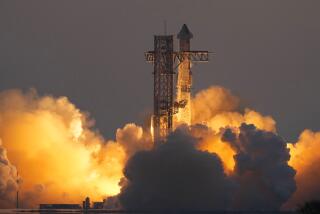10th Try the Charm as Titan 3 Blasts Off : Space: Launch follows 9 postponements. It’s the debut of a second private U.S. firm hauling payloads into space for a fee.
- Share via
CAPE CANAVERAL, Fla. — A Titan 3 rocket carrying British and Japanese communications satellites roared into space Sunday night after nine postponements as Martin Marietta Corp. entered the commercial launch business.
The 155-foot-tall booster blasted away from its launch pad at the Cape Canaveral Air Force Station at 7:07 p.m. and gave thousands of spectators a dazzling New Year’s Eve show, brilliantly lighting the night sky as it climbed toward orbit.
“Everything looks good,” mission commentator Bob Gordon reported as the rocket sped into space. Twenty minutes after liftoff mission director Vic Whitehead reported the Titan 3 upper stage carrying the satellites had achieved a successful orbit ranging from 117 to 437 miles high.
The Titan got away on its 10th attempt. Originally set for Dec. 7, the launch was delayed once by a technical problem and eight times by strong, high altitude winds. The wind was no problem Sunday night and the countdown proceeded without a hitch to an on-time liftoff.
Packed in the nose cone of the most powerful U.S. commercial rocket were the 14,700-pound JCSAT-2 and the 3,230-pound Skynet 4 satellites.
Skynet 4A was ejected from the Titan’s nose cone into its planned preliminary orbit a little more than an hour after launch and JCSAT 2 followed about an hour and a half later. On-board rocket motors were to boost the relay stations to their operational altitude of 22,300 miles.
JCSAT-2 will complete a two-satellite Japanese domestic network, providing telephone, television, facsimile and high-speed data services. It is owned by the Japanese Communications Satellite Co.
Skynet 4 will be used by the British Ministry of Defense for communicating with land, sea and air forces.
The Japanese company and British government share the $125-million cost of the rocket and launch services provided by Martin Marietta.
Roaring with power, the Titan’s boosters burned out about two minutes after liftoff as planned and fell away into the Atlantic Ocean. The liquid-fueled Titan “core” vehicle then continued the ascent, looking like a brilliant star as the vehicle disappeared to the east.
The flight plan called for Skynet 4 to be deployed from the Titan’s second-stage nose cone one hour and 12 minutes after liftoff. JCSAT-2 was to follow suit about an hour and a half after that.
The Titan 3, built at Martin Marietta’s Denver plant, is the second big U.S. rocket to enter the commercial market, launching payloads for a fee. McDonnell Douglas was the first, with its Delta rocket hoisting a communications satellite for British Satellite Broadcasting in August.
General Dynamics plans to enter the competition next year with its Atlas rocket.
The three U.S. companies are competing with the European Space Agency’s Ariane rocket.
More to Read
Sign up for Essential California
The most important California stories and recommendations in your inbox every morning.
You may occasionally receive promotional content from the Los Angeles Times.










